Julie’s & Nicole’s Paper Aipan
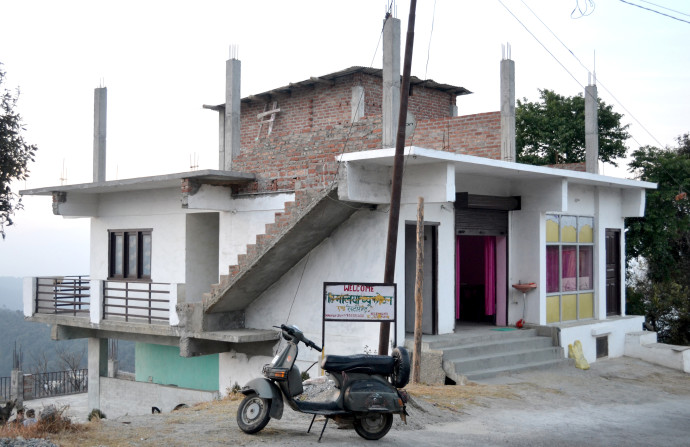
This half-built hotel was home base for PECAH 2016. (Except where indicated, all photos are by Scott Ponemone)
INTRODUCTION
On my last morning near the Uttarakhand (India) village of Manila I was ready to leave my half-built hotel as usual at 6:30 to take my daily hour’s walk. But I didn’t immediately set out because I heard women’s voices coming from the dining area (inside the open steel roll-up door in the photo). That was odd since only men worked at the hotel, located in the Himalayan foothills, about 6,000 feet up. So I peeked in to find Nicole Schlosser and Julie Parenteau busy at work making cuts to large sheets of white paper that they had taped together and drawn a design in the aipan tradition. The best way to explain that tradition is to link you to ART I MAKE blog post of mine that describes my attempt to adapt aipan to my own art-making: http://www.scottponemone.com/lessons-in-aipan/.
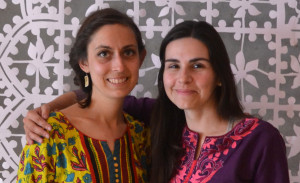
Nicole Schlosser (L) and Julie Parenteau.
Like myself, artists Nicole and Julie–both Canadians–had come to Manila to participate in PECAH (Programme of Exchange in Culture and Art of Himalayas), a month’s long residency that introduces visiting artists to Indian art and craft traditions. (I got instruction in yoga, helped prepare meals for a week, and worked in two regional art traditions: pattachitra and, of course, aipan.) The three other international participants came from Mexico, France and Australia. Our India hosts all lived in the small city of Ramnagar, far below Manila, about 3.5 hours by bus along a twisty, narrow, partially-under-construction road. PECAH is one of the programs operated by the BHOR Society and it’s director Sanjay Rikhari. Details about BHOR can be found at: http://bhor.org/, while PECAH info is at: http://bhor.org/articles-2/pecah/.
Both Julie and Nicole were a bit giddy that morning. They had spent all night on the paper aipan project. I was instantly fascinated by the inspiration and ambition that their project exhibited. So when the PECAH residency ended in Ramnagar for a two-day festival of dance, music and art, I photographed the installation of their paper aipan. Before they suspended their aipan with thread from an overhead beam, they surprised me again. Nicole and Julie laid it on the floor and did a tracing of their aipan in pencil. This they would paint in the traditional aipan background color of burnt siena (called “terracotta” by the locals). So their finished project consisted of the hung paper aipan, the negative of it painted on the floor in front of it, and the shadow of the paper aipan project on the wall behind it.
Happily both artists agreed to answer some questions about their project once they finished with their travels. (Short bios of the artists follow this interview.)
INTERVIEWS
I asked the same set of questions to both artists. Instead of trying to interweave their responses, I kept them separate.
What did you think about the Aipan tradition?
Nicole Schlosser: I think it’s one of the most beautiful art forms I have ever encountered. I like how detailed it can be, and yet at the same time it’s very simple. I like how almost everything in the design holds meaning. I like how the materials used are not harmful for the environment (terracotta and rice). I like that it’s an art form that is used to celebrate special occasions and the everyday. I like that the work is so temporal.
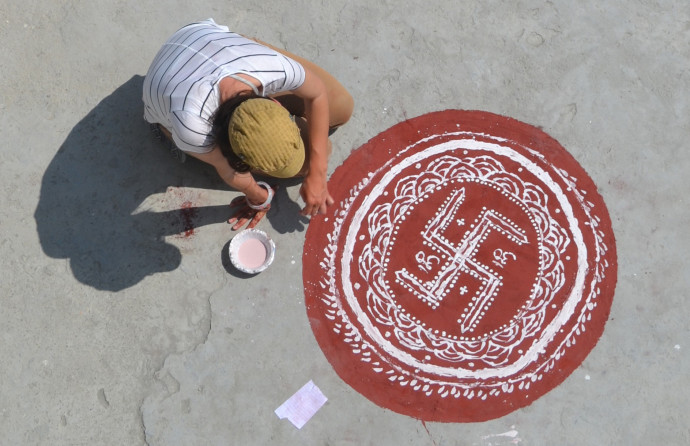
During the first day of aipan class we followed traditional aipan techniques. After making a circle in terracotta-colored paint, Julie drew her design with her fingers with white paint made from ground rice and water.
Julie Parenteau: For me, making the aipan was a very soothing process. The repetition of the patterns and the small details felt almost like a form of meditation. I like the fact that every line and dot have a significance and a purpose in the whole. I especially enjoyed taking part in the making of the paint itself with the grinding of the rice and the mixing of red pigment with water.
What intrigued you about it?
Nicole: I think for me the thing that made it most intriguing was also the thing that almost made me not want to take the workshop. Traditionally aipan is done on the floor and will be either trampled or washed away. It’s meant to be temporal; the destruction of each piece is inevitable. Because there is so much work that goes into it, the idea of it being destroyed is a bit of a barrier to getting started.
Julie: I think that what intrigued me the most in this tradition was its dual purpose, both aesthetic and also a ritual of protection and blessing. In this sense, I liked working directly on the floor and the idea that the piece will just naturally disappear over time.
You both did rather complicated copies of aipans in miniature. What effect did doing that have on you?
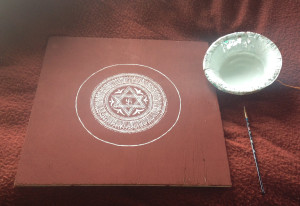
A work in progress: Nicole’s small aipan on plywood. (Photo by Nicole Schlosser)
Nicole: I really love working small and with lots of detail like that. I lose myself in that sort of work, where the process is tedious and repetitive. I wouldn’t say it has a calming effect, but something along those lines.
What were the origins of the idea for the paper aipan?
Nicole: Julie said something about the aipans looking like lace and wanting to do an installation for the exhibition. I thought we should use terracotta in the installation. That’s the only thing I remember feeling strongly about. To be honest, I don’t really remember exactly, but Julie was the brains behind this project.
Julie: The very delicate and complex patterns painted in white and attached to each other reminded me of lace. I wanted to lift them in the air like a fine embroidery.
When did this idea materialize?
Nicole: A few days before the exhibition Julie said she wanted to do an installation and asked if I would collaborate. I was game and started looking into supplies before we even knew exactly what we were going to do. We had a plan and started working two nights before the exhibition.
Julie: We had talked about the idea for a day or two, then we decided to do it. All we required was a knife and paper. Luckily Nicole had brought a paper cutter with her. We went to the village of Manila to purchase the paper. We were able to find some that was both resistant and thin enough for the project. Because the store did not carry large format, we took about 20 smaller sheets and attach them together. Later Himanshu Sharma provided us with a second much needed X-Acto knife that allowed us to finish on time.
Why did you want to make it so big?
Nicole: Because it’s more impressive. I think aipans can be a range of sizes traditionally. For this exhibition specifically it needed to be big in order to not get lost in the space with all the other things going on.
Julie: As for the size, I thought it needed to have a certain presence, with some lightness but to be felt in the room.
How did you translate a small aipan pattern into your paper aipan? How did you divide your labor in producing the paper aipan? What problems did you run into and how did you solve them?
Nicole: Honestly time had a lot to do with it. We picked an Aipan design that was intricate and “dumbed it down” so that we could draw just one quarter and then trace it. We only had one paper cutter with a few replacement blades … so one person would draw or trace while the other person cut and then we would switch. I don’t think there were any unusual problems. Because time was an issue, sleep was an issue. We listened to oldies and were constantly rewarded by our progress.
Julie: We chose an aipan model that we both liked but had not worked on before. We started the drawing and slightly modified the model to fit better. The division of the task came naturally and flowed.
I don’t recall that we ran into any problems in the making of the paper creation. Except that when we started we had only one paper cutter. So we took turns on drawing and cutting.
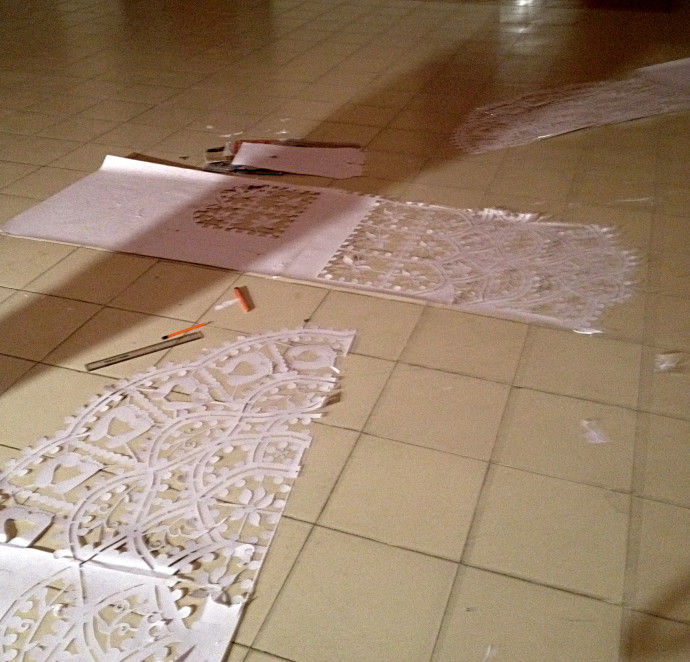
The last cuts on the paper aipan were done on the floor of the exhibition hall. (Photo by Nicole Schlosser)
I saw you around 6:30 a.m. You said you pulled an all-nighter. When did you start and when did you finish? How did you manage to keep going? Just how tired were you when you finished?
Nicole: We started two nights before the exhibition around 9 p.m. and finished within the hour of the opening! Like I said before, it was a really rewarding process. Each part that was completed just made us more excited to get it done. Also everyone who would see us working on it was encouraging, and we had people stepping in all along the way to help. Himanshu was a life saver. When we finished, I think I was too proud to be tired, but once the exhibition space started to clear out the opening night, sleep swooped in like the rising tide.
Julie: We started after dinner I would say around 9:30 p.m. We worked until morning and took a break for breakfast. Then we continued until it was time to pack and get ready to leave to Ramnagar.
Later that night we worked again for several hours and finally finished the piece the morning after. Surprisingly in the night we were not tired. I think we were so involved into the process that it kept us awake and enthusiastic. The beauty of working during the night is that everyone is sleeping and so there are no distractions. Time is still somehow. It is easier to be completely focused.
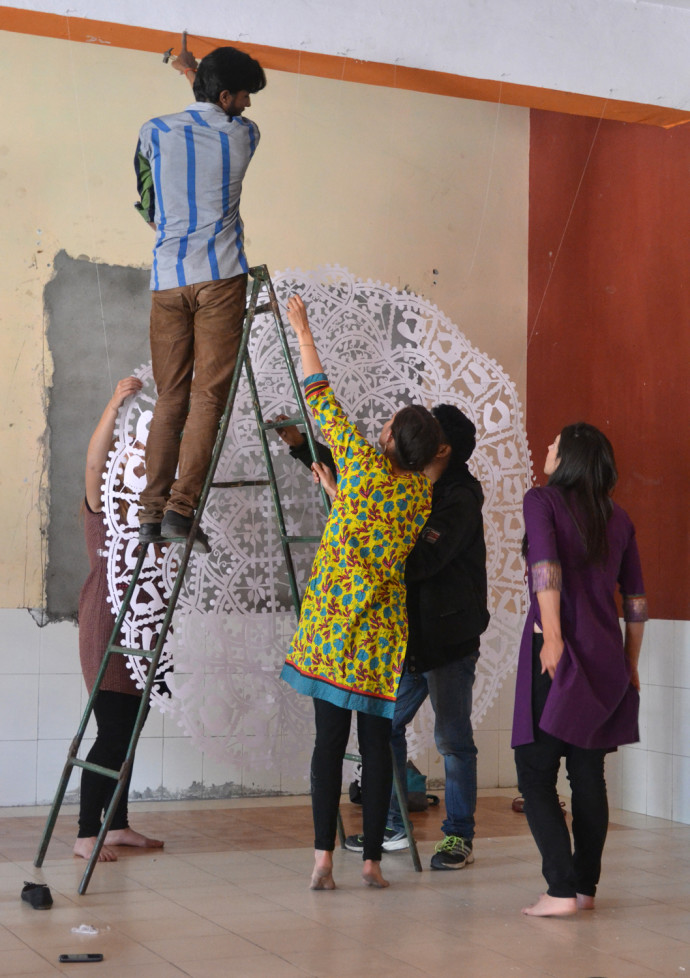
Himanshu Sharma on the ladder was tireless in his efforts to get the paper aipan to hang right.
What complications did you run into hanging it?
Nicole: So many haha! First all the nails kept falling out of the cement wall. People were trying to keep the exhibition space neat and tidy. So things would be put away and forgotten about, and we lost a lot of materials. To hang the piece we ended up having to use thread, which was both fragile and was cutting up the paper. Getting the angles right so that it would hang straight would have been a nightmare due to our sleep deprived minds, but Himanshu had limitless patience and know-how.
Julie: We did not have the right kind of nails for the wall. They were falling off. The piece required several lengths of threads to hang straight down. There were a lot of adjustments, and with the nails that kept falling it was not ideal. Overall I would say that the main complication was that we were running out of time. Again, luckily we had Himanshu to the rescue!

Maëlle Maisonneuve (top) helps Nicole (left) and Julie (right) trace the aipan on the floor.
Did you always intend to trace it on the floor before hanging it? When and how did that idea germinate?
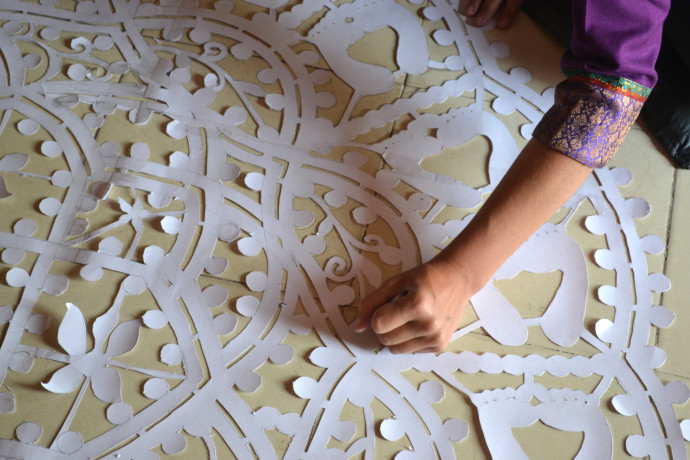
Julie tracing the paper aipan.
Nicole: Tracing and painting was always part of the plan. It was all decided before we got to work.
Julie: Yes, we had this in mind since the beginning. When we developed the idea originally, we knew we wanted to play with the negative space. This was our way to incorporate it in the composition. By tracing it directly from our piece, we knew it would be accurate.
How did you have the energy to paint the floor version? Could you have painted the floor aipan without help?
Nicole: For me the piece was not complete without the painting on the floor. We had already gone so far, how could we have stopped? Plus I think at this point we were so elated that tiredness was a vague idea. We would not have been able to get it done in time without the help of everyone who joined us. Granted some of the help came in the form of children and was actually more time consuming because we had to redo their parts, but there was something really amazing with all these people joining us.
Julie: Since we had invested time and effort into the art piece, we were just very excited to get to see the final result. We were satisfied with the piece, and doing the painting on the floor was a reward not a chore. Many people came to help us. They sat and naturally they grabbed a paint brush and started to paint. It was great. The art became a collaborative piece. In the aipan tradition, the diagrams are made, they become a blessing for prosperity to the place as well as for people who created them. We were sharing this all together.
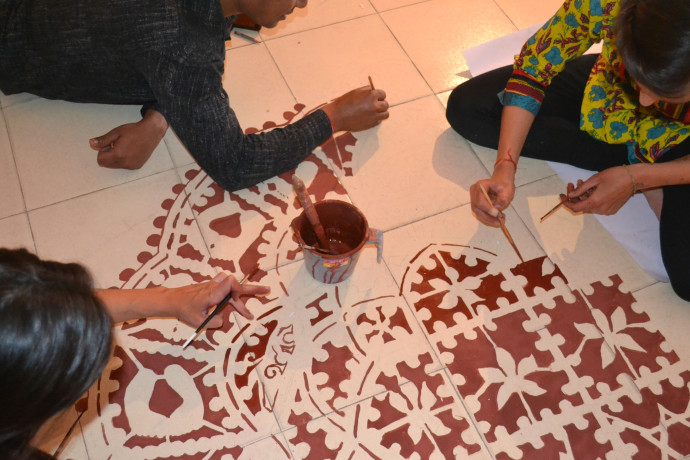
Painting the traced aipan.
I like how the floor version was the negative of the paper one (except to the outside perimeter dots). Whose idea was it to paint the outside dots?
Nicole: Julie and I were not sure how to finish it off and then Manav [Joshi] came and started doing the perimeter dots like that, and we were like: “OK, I guess that’s perfect.”
Julie: It was our beloved Manav, our aipan instructor, who suggested it!
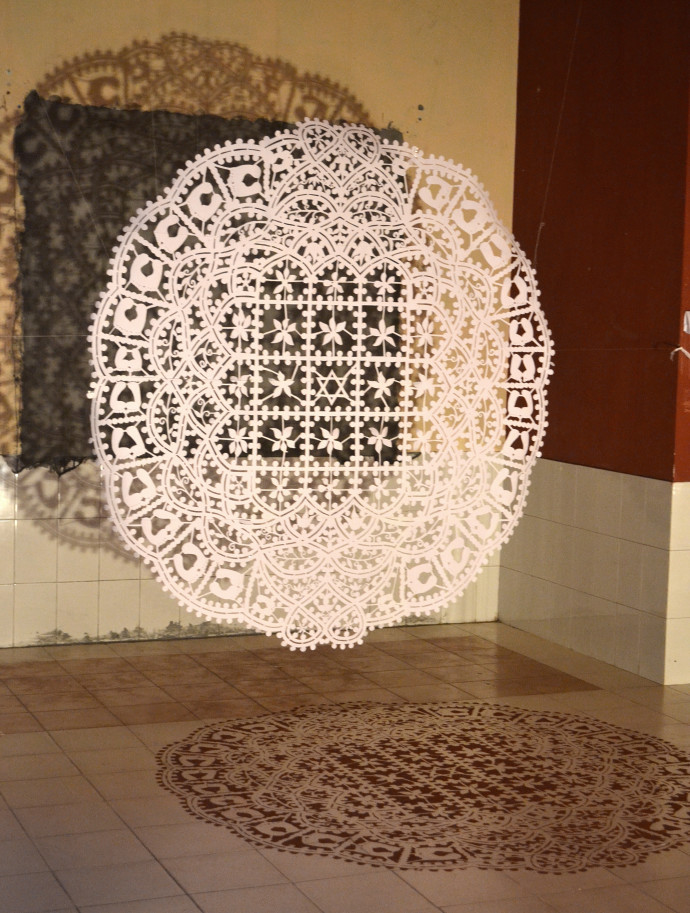
Completed installation. Note the cast shadow.
Did you always intend to cast a shadow behind the hanging aipan? Did the lighting work out for you?
Nicole: Yes,the lighting was funny. Originally they gave us a sort of rave light that changed colors, and I remember feeling this sense of panic. Once we got a white light, it was hard to get the shadow crisp enough. And of course every time you turned your back someone would move the spotlight. I think a lot of people felt ownership in a way and wanted it to look it’s best. So the spotlight was forever moving.
Julie: Yes we were hoping that the shadow would project on the wall the image and patterns. It worked OK, but not as much as I would have liked. I was hoping for a more crisp shadow. I think we hung the piece a bit too far from the wall for that. Although the lighting was not ideal, overall it works.
How did spectators respond to your project?
Nicole: They loved it.
Julie: I think we got a good response. Himanshu told me that they kept the piece and used it for the Baithiki celebration, another event of the BHOR Society. So I guess this is a good sign!
In what way did your project meet your expectations? What did you learn from it? How do you think your collaboration went?
Nicole: I was really happy with final project. I think I learned mostly the benefits of working in collaboration. I really enjoyed working with Julie and hope we can work together again in the future.
Julie: In my opinion our collaboration went very well. We were a good team! I did not have any particular expectation. We had an idea, and we materialized it. I am happy with the result.
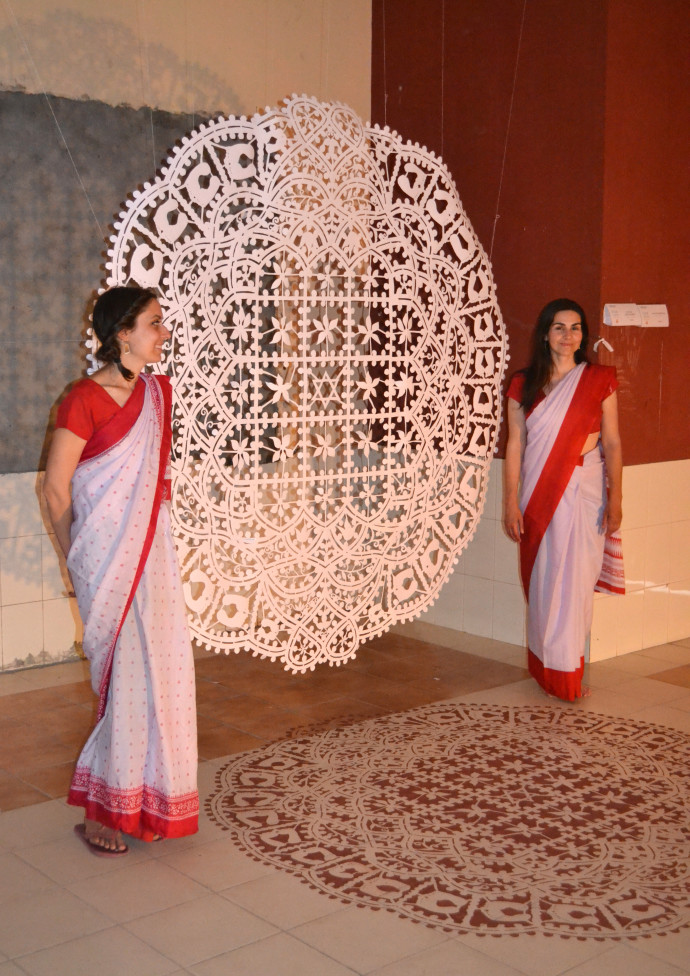
Nicole and Julie in festival dress. (This is the first time I noticed that they placed a 6-pointed star in the middle instead of the traditional swastik.)
Do you think your translation of the aipan tradition change the tradition or change how you look at aipan?
Nicole: I think it changed how I look at Aipan. As a foreigner I’m not sure how much of a right I have to change a tradition that doesn’t belong to me, but I think people appreciated that Julie and I started to explore this art form and give it a place in contemporary art. The BHOR Society exists to promote arts and culture of the Uttarakhand region, and PECAH exists specifically to share these traditional art forms with foreigners. Realistically we didn’t change very much because Aipan exists to celebrate special moments. Even though the aipan manifested in a different form in our work, it still served the same purpose.
Julie: This is a difficult question. I think doing the actual aipan made me reflect on the process in a deeper way by considering the meaning behind it. Doing the project made me look at aipan in a more formal matter, appreciating its design and the aesthetic beauty of it.
How do you think the project will influence your own art making? Has it already?
Nicole: I am more keen on working in collaboration that I was before, and I am less afraid of projects that are sure to meet with a sure death. I think this project has given me a boost of confidence. It was more successful than I imagined it could be, and we had such a short time frame to work within and so few materials to work with.
Julie: I had mentioned before I liked making the paint by mixing the red pigment with water. This process really made me think about painting in a different way. Same goes for the act of painting directly on the wall or on the floor without the support of a panel or a canvas. There is something extremely beautiful in the idea of making art with almost nothing and let it live and disappear simply with life happening around it. Aipan inspired me to do this, use natural pigment and go paint everywhere! I think it changed my art practice by making me want to do art in a simpler way, perhaps closer to the earth.
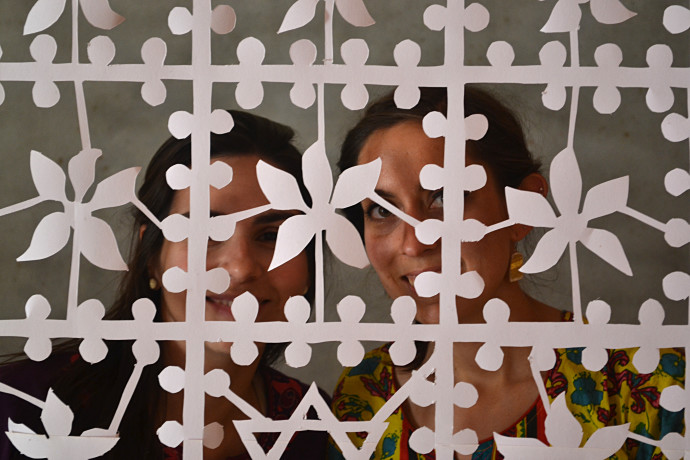
SHORT BIOS
Julie Parenteau
Julie is an artist and art educator who graduated from the École des arts visuels et mediatique de l’Universite du Quebec a Montreal UQAM. Her work is always closely linked to notions of landscape. Julie says, “I love art for its gathering power. My research interests focus on the possible influence of the environment of an individual on his creativity.”
She is a member of Collectif Escargo, which, she says, “combines visual arts, design and landscape architecture to create public arts installations. We do every part of a project as a team, from conception to realization. This allows us to undertake bigger ventures and to share the fun of creation. For me, it is a good balance to have both, personal projects that I present in galleries and collective works presented in a public art context.” The collective’s website is: collectifescargo.com
Her own website is: jparenteau.com
Nicole Schlosser
Nicole grew up in Hamilton, Ontario and now lives and practices in Trois-Rivières, Québec. She belongs to the collective L’Atelier Presse Papier: http://www.pressepapier.ca/Atelier
Her work has been featured in many exhibitions and festivals including 2010 Arts FEST in Mississauga, Ontario, where she received Best Video Work. She has exhibited in many galleries and cultural centers throughout North America, Europe and Asia. Her work is part of numerous private and public collections including that of the Juravinski Hospital in Hamilton, Ontario, and that of Glasgow University in Scotland.
Her website is: https://blankspacesemptyplaces.wordpress.com/
Trackback URL: https://www.scottponemone.com/julies-nicoles-paper-aipan/trackback/












I was waiting to read this after your last Aidan post, and I really enjoyed reading about this fabulous collaboration. I loved the work, the paper and also the stencil on the floor. So cool!
this is extream efforts of two canadian girls i really insipired to them and they did 2 night and 1 day hard work on this project and they never slept till not this project completed its honour to me that i was also a little part of this project thanks julie and nicole and scott
What a great story Scott, so inspiring, Thanks, soledad
Thank you for interviewing these immensely talented artists and sharing their views and experiences in this blog. I got to know a lot about aipan artwork and the effort that goes in making theese intricate patterns. And special thanks to BHOR and PECAH for taking this initiative of art residency and allowing artists to explore the art work of different countries.
Thanks, Aditi. I’ll pass your comments along to Nicole and Julie as well as people at BHOR. Yours, Scott